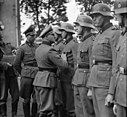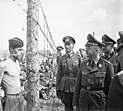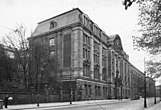
Back Schutzstaffel Afrikaans Schutzstaffel ALS Schutzstaffel AN قوات الأمن الخاصة النازية Arabic وحدات النخبه النازيه (س.س) ARZ Schutzstaffel AST Mühafizə dəstəsi Azerbaijani اس اس AZB СС Byelorussian СС BE-X-OLD
 SS flag | |
| |
| Agency overview | |
|---|---|
| Formed | 4 April 1925[1] |
| Preceding agencies | |
| Dissolved | 8 May 1945 |
| Type | Paramilitary |
| Jurisdiction | Nazi Germany and German-occupied Europe |
| Headquarters | Prinz-Albrecht-Straße, Berlin 52°30′25″N 13°22′58″E / 52.50694°N 13.38278°E |
| Employees | 800,000 (c. 1944) |
| Reichsführer responsible |
|
| Parent agency | Nazi Party Sturmabteilung (until July 1934) |
| Child agencies |
|
The Schutzstaffel (SS; also stylised as ᛋᛋ with Armanen runes; German pronunciation: [ˈʃʊtsˌʃtafl̩] ⓘ; lit. 'Protection Squadron') was a major paramilitary organisation under Adolf Hitler and the Nazi Party in Nazi Germany, and later throughout German-occupied Europe during World War II.
It began with a small guard unit known as the Saal-Schutz ("Hall Security") made up of party volunteers to provide security for party meetings in Munich. In 1925, Heinrich Himmler joined the unit, which had by then been reformed and given its final name. Under his direction (1929–1945) it grew from a small paramilitary formation during the Weimar Republic to one of the most powerful organisations in Nazi Germany. From the time of the Nazi Party's rise to power until the regime's collapse in 1945, the SS was the foremost agency of security, mass surveillance, and state terrorism within Germany and German-occupied Europe.
The two main constituent groups were the Allgemeine SS (General SS) and Waffen-SS (Armed SS). The Allgemeine SS was responsible for enforcing the racial policy of Nazi Germany and general policing, whereas the Waffen-SS consisted of the combat units of the SS, with a sworn allegiance to Hitler. A third component of the SS, the SS-Totenkopfverbände (SS-TV; "Death's Head Units"[2]), ran the concentration camps and extermination camps. Additional subdivisions of the SS included the Gestapo and the Sicherheitsdienst (SD) organisations. They were tasked with the detection of actual or potential enemies of the Nazi state, the neutralisation of any opposition, policing the German people for their commitment to Nazi ideology, and providing domestic and foreign intelligence.
The SS was the organisation most responsible for the genocidal murder of an estimated 5.5 to 6 million Jews and millions of other victims during the Holocaust.[3] Members of all of its branches committed war crimes and crimes against humanity during World War II (1939–45). The SS was also involved in commercial enterprises and exploited concentration camp inmates as slave labour. After Nazi Germany's defeat, the SS and the Nazi Party were judged by the International Military Tribunal at Nuremberg to be criminal organisations. Ernst Kaltenbrunner, the highest-ranking surviving SS main department chief, was found guilty of crimes against humanity at the Nuremberg trials and hanged in 1946.
- ^ Weale 2010, p. 26.
- ^ McNab 2009, p. 137.
- ^ Evans 2008, p. 318.





